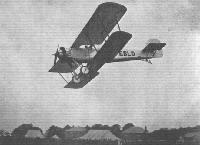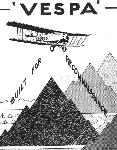
Vickers Type 113 Vespa
Vickers Type 113 Vespa Mk I совершил первый полет в сентябре 1925 года. Он был построен компанией в инициативном порядке под тактико-технические требования 30/24 британского Министерства авиации к самолетам взаимодействия с наземными войсками. Конструктивно он представлял собой неравнокрылый биплан, крылья которого были значительно смещены относительно друг друга, а две его открытые кабины располагались тандемно. Самолет оснащался двигателем Bristol Jupiter IV, который позже был заменен на Jupiter VI мощностью 455 л. с. После повреждений, полученных в июне 1926 года, самолет был переработан и получил обозначение Type 119 Vespa Mk II. Теперь его крылья имели металлическую конструкцию. Он успешно прошел испытания, но на вооружение британских ВВС так и не поступил. Однако шесть самолетов под обозначением Type 149 Vespa Mk III, имевшие некоторые усовершенствования планера, в 1929 году были поставлены в Боливию. В том же году поступил заказ от ирландского Авиакорпуса на четыре самолета с двигателем Armstrong Siddeley Jaguar VIC мощностью 490 л. с, они получили обозначение Type 193 Vespa Mk IV. Еще четыре самолета с некоторыми усовершенствованиями были впоследствии построены для Ирландии как Type 208 Vespa Mk V.
В 1930 году самолет Vespa Mk II прошел модернизацию по стандарту Vespa Mk IV и теперь оснащался мотором Bristol Jupiter VIIF мощностью 530 л.с.Новая модификация получила обозначение Type 210 Vespa MkVI. Самолет совершил турне в Китай, но после возвращения в Великобританию был вновь модернизирован - на самолет, получивший обозначение Type 250 Vespa Mk VII, установили двигатель Bristol Pegasus «S» с турбонагнетателем. 16 сентября 1932 года на этом самолете был установлен новый мировой рекорд высоты полета - 13 404 м, после чего он был приобретен Министерством авиации и использовался Королевским авиационным научно-исследовательским институтом для высотных исследований.
- Описание
Фотографии
-
Flight 1926-07 / Flight
The Vickers "Vespa" (Bristol "Jupiter") Reference has already been made to three of the four new Army cooperation machines taking part in the "Fly-past." The fourth is the "Vespa" designed by Mr. Rex Pierson and built by Vickers, Limited. The ability to fly very slowly is a desirable feature in an Army co-operation machine, and it will be seen that the "Vespa" has a large wing area. A somewhat unusual feature of the design is that the fuselage does not rest on the bottom plane, as is usually the case, a gap being left between the fuselage and the lower wing. The fuselage is of relatively small cross-sectional area, and the biplane wings are of unequal span and chord.
-
Air Enthusiast 1972-08 / In print
Самолет Vespa IV в Бруклендсе непосредственно перед поставкой ирландскому Авиакорпусу. Биплан имел металлические крылья и стойки.
The Vickers Vespa, one of the prototypes of which is shown here, was tested by No 2 Squadron alongside three competing types prior to selection of the AW Atlas as the new Army Cooperation aircraft for the RAF. -
Flight 1930-11 / Flight
Vickers Vespa Army Co-operation biplane.
-
Flight 1930-04 / Flight
FOR THE IRISH FREE STATE: A most successful acceptance test flight has been accomplished with the first Vickers "Vespa IV." Army Co-operation aircraft, fitted with an Armstrong-Siddeley "Jaguar IVc" engine shown here, for the Army Air Corps of the Irish Free State. The performance put up by the machine was 135 m.p.h. at 15,000 ft.
-
Flight 1932-01 / Flight
Регистрационный номер: G-ABIL [11] OPERATING THE PUMP ON A VICKERS "VESPA" (JUPITER): The man standing in front of the tail trolley is working the pump.
-
Flight 1927-08 / Flight
Регистрационный номер: G-EBLD [2] A Curious Mishap: Sqdn.-Leader Payn landing the Vickers "Vespa" after the second lap. On the third lap the Hucks coupler on the propeller (visible in the photograph) came adrift and caused some damage, compelling Payn to land.
-
Flight 1931-04 / Flight
OFF TO IRELAND: Two Vickers "Vespas" with "Jaguar" engines left Weybridge at 12 noon on March 31 and arrived at Sealand at 1 o'clock, having made the journey in exactly one hour. The machines, which are part of an order for the Irish Free State, were piloted by Mr. J. Summers and Captain T. Neville Stack.
-
Aviation Historian 10 / T.Buttler - On Heaven's Doorstep
Регистрационный номер: G-ABIL [11] VICKERS "VESPAS" FOR IRISH FREE STATE AND CHINA: A repeat order has been placed by the Irish Free State Army Air Corps with Vickers (Aviation) Ltd., for four "Vespa" Army Co-operation machines fitted with Armstrong-Siddeley "Jaguar" engines. A "Vespa VI" (Bristol "Jupiter"), as shown here, has also been sent out to China for the purpose of special demonstration flights to the representatives of the National Government of China.
The first Vespa built, originally registered G-EBLD, became the much-modified Vespa VI, re-registered as G-ABIL in January 1931. -
Aeroplane Monthly 1976-06 / Personal album
Регистрационный номер: K3588 K3588 was the Vickers 210 Vespa VII, previously Vespa I G-EBLD and Vespa II and VI G-ABTL/O-S. First flown in September 1925, the aircraft had a long and varied history. On September 16, 1932, Bristol's chief test pilot, Cyril Uwins, flew it to a new world altitude record of 43,976ft, a Bristol Pegasus "S" supercharged engine being fitted for this flight. It is seen at the RAF Display, Hendon, in 1933, shortly after its acquisition by the RAF in June of that year for high-altitude research.
-
Flight 1930-11 / Flight
AT BALDONNELL AERODROME: A Vickers "Vespa" (Armstrong Siddeley "Jaguar"), one of the types used by the Irish Free State Army Air Corps.
-
Air International 1995-08 / Fighter A to Z
В течение 1920-1930-х годов самолеты «Vickers» активно продавались за границу. Данная линейка самолетов запечатлена в Боливии. На фотографии - четыре Vickers Bolivian Scout (справа) и три Vickers Vespa.
One of the six Bolivian Scouts, at Alto La Paz in 1931.Другие самолёты на фотографии: Vickers Scout / Type 141 / Bolivian Scout / Type 143 / Type 177 - Великобритания - 1928
-
Мировая Авиация 102
Регистрационный номер: G-ABIL [11] 1932 год - 13404 м. 16 сентября 1932 года капитан С.Ф.Увинс на биплане Vickers Vespa VII вплотную подошел к высоте 13411 м. Самолет для установления рекорда прошел доработку, на нем установили мотор с нагнетателем.
THE VICKERS "VESPA": This photograph shows the machine flown by Uwins in the altitude record attempt. The Bristol "Pegasus" (supercharged) engine was fitted. -
Aviation Historian 10 / T.Buttler - On Heaven's Doorstep
Регистрационный номер: G-ABIL [11] Following its sojourn in China, G-ABIL was modified again (note the filled-in upper wing centre section), fitted with a Pegasus engine with Townend ring and redesignated the Vespa VII.
-
Aviation Historian 10 / T.Buttler - On Heaven's Doorstep
Регистрационный номер: G-ABIL [11] Uwins in the cockpit of G-ABIL in 1932. The “O-5” on the Vespa’s fuselage is the marking it wore while operating under “B Conditions” (without a valid Certificate of Airworthiness). In May 1933 G-ABIL went to the RAF, with which it was given the serial K3588 and used for high-altitude and supercharger research.
-
Flight 1932-09 / Flight
EQUAL TO 1,100 H.P.: The Bristol "Pegasus" engine would develop at ground level, could it be run at full supercharge, this impressive power. Note the Townend ring cowling.
-
Aviation Historian 10 / T.Buttler - On Heaven's Doorstep
Регистрационный номер: G-ABIL [11] TESTING THE ALTITUDE BREAKER: Mr. C. F. Uwins flying the Vickers "Vespa" (Bristol "Pegasus") above the Bristol Channel. The English end of the Severn Tunnel can be seen in the foreground. 1932.
Uwins at the controls of record-setting Vickers Vespa G-ABIL above the Bristol Channel in 1932. -
Aviation Historian 10 / T.Buttler - On Heaven's Doorstep
Регистрационный номер: G-ABIL [11] "PER ARDUA AD ASTRA": The Vickers "Vespa" (special supercharged Bristol "Pegasus") on the way towards 44,000 ft. Piloted by Capt. C. F. Uwins, it gained the altitude record in 1932 with a height of 44,000 ft. An Italian Pegasus-engined Caproni subsequently raised the figure to 47,353 ft.
The Vespa during one of the high-altitude flights made in September 1932. Uwins reported that on the earlier flights a degree of aileron control had been lost owing to differences in expansion and contraction of metal parts in the wing, but that other than that, the flights were “uneventful to the point of being boring”. -
Flight 1932-09 / Flight
Регистрационный номер: G-ABIL [11] "SPAN SQUARE OVER W": The Vickers "Vespa" (Bristol "Pegasus") is characterised by large span and, consequently, low span loading.
-
Aviation Historian 10 / T.Buttler - On Heaven's Doorstep
Регистрационный номер: G-ABIL [11] On top of the world - the original Flight caption for this photograph of Uwins wearing his heated flying suit, goggles and oxygen mask in G-ABIL, states that it was taken "to give people an idea of what he looked like when he looked down on this vale of tears from 44,000ft”. He was in fact looking down on the Vale of Evesham.
-
Aviation Historian 10 / T.Buttler - On Heaven's Doorstep
Регистрационный номер: G-ABIL [11] In the cockpit the spade-handle grip of the control column had a safety switch which the pilot had to keep in position in order to keep the engine running. The object was to ensure that, in the event of the pilot losing consciousness, his grip on the switch would relax, with the result that the engine would automatically cut out, eliminating the possibility of a full-power dive and giving the pilot time to regain consciousness and re-establish control. The device had successfully been called into play on a number of occasions.
-
Aviation Historian 10 / T.Buttler - On Heaven's Doorstep
Регистрационный номер: G-ABIL [11] The starboard side of the cockpit accommodated the Rotax control box for Uwins’s heating equipment, with switches for goggles, clothing and oxygen.
-
Flight 1929-12 / Flight Advertisements
Регистрационный номер: G-EBLD [2]
- Фотографии





















